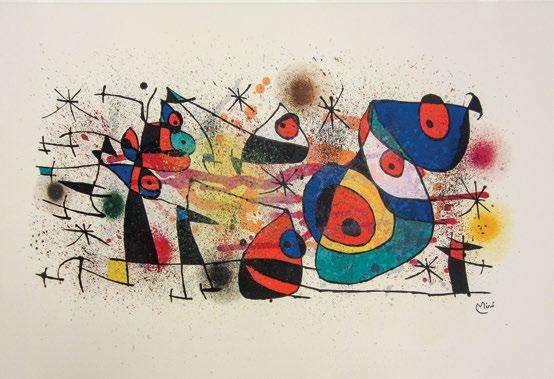

Eclectic Abstraction
From Matta and Miró to Rick Bartow
Abstracción ecléctica: de Matta y Miró a Rick Bartow
GALLERY GUIDE
GUÍA DE GALERÍA

Eclectic Abstraction
From Matta and Miró to Rick Bartow
Eclectic Abstraction: From Matta and Miró to Rick Bartow features non-representational artworks as well as figurative work from the JSMA’s collection that diverges from naturalism, reflecting not only a tension between forms, but artistic freedom and independence from style, subject matter, and context. The exhibition offers an intergenerational and transnational perspective, and more than seventy percent of the works have never been exhibited before at the museum. Many of the selected artists lived through turbulent times and experienced World War I, World War II, civil war, wars with foreign countries, and dictatorships—among them Joan Miró, Rufino Tamayo, Roberto Matta, Betty Feves, George Johanson, and Rick Bartow. Other artists in the exhibition, such as Ka’ila Farrell-Smith and Emma Kohlmann, have similarly witnessed drastic changes in the global world order.
Oscillating between art and politics, figuration and abstraction, artists in the exhibition subtly champion freedom amidst social turmoil. As Joan Miró declared:
After the Nazi invasion of France and Franco’s victory [in the Spanish Civil War], I was sure they wouldn’t let me go on painting, that I would only be able to go to the beach and draw in the sand or draw figures with the smoke from my cigarette….I gave the paintings very poetic titles because that was the line I had chosen to take and because the only thing left for me in the world then was poetry.
Denouncing wars, authoritarianism, repression, and social injustice, these artists embraced distinct activist roles both within and outside their fields. As they confronted hopelessness, fear, and anxiety, they joined and supported resistance through artistic means, public speeches, and writings. Their work demonstrates a commitment to free expression and artistic experimentation in the face of uncertainty and repression, whether through whimsical and joyous bodily displays, or in more frightening representations of fragmented bodies that invite reflection on their times, and ours today.
The exhibition is curated by Dr. Adriana Miramontes Olivas, Curator of Academic Programs and Latin American and Caribbean Art.
Rick Bartow (b. 1946 Newport, OR – 2016). Native American, Mad River band of the Wiyot Tribe.

Abstracción aecléctica de Matta y Miró a Rick Bartow
Abstracción ecléctica: de Matta y Miró a Rick Bartow presenta obras de arte de la colección del JSMA no representativas, así como también obras figurativas que difieren del naturalismo, reflejando no solamente una tensión entre las formas, sino también una libertad artística e independencia del estilo, tema y contexto. La exposición ofrece una perspectiva intergeneracional y transnacional, y más del setenta por ciento de las obras nunca se habían expuesto antes en el museo. Muchos de los artistas seleccionados vivieron durante tiempos turbulentos y experimentaron la Primera Guerra Mundial, la Segunda Guerra Mundial, guerras civiles, guerras con países extranjeros y dictaduras, incluyendo Joan Miró, Rufino Tamayo, Roberto Matta, Betty Feves, George Johanson y Rick Bartow. Otros artistas de la exposición como Ka’ila Farrell-Smith y Emma Kohlmann también han sido testigos de cambios drásticos en el orden mundial.
Oscilando entre el arte y la política, la figuración y la abstracción, los artistas de esta exposición defienden sutilmente la libertad en medio de la agitación social. Como declaró Joan Miró:
Después de la invasión nazi de Francia y la victoria de Franco [en la Guerra Civil Española], yo estaba seguro de que no me dejarían seguir pintando, de que solamente podría ir a la playa y dibujar en la arena o dibujar figuras con el humo de mi cigarrillo….Le puse a las pinturas unos títulos muy poéticos porque ésa era la línea que yo había elegido seguir y porque lo único que me quedaba entonces en el mundo era la poesía.
Denunciando las guerras, el autoritarismo, la represión y la injusticia social, estos artistas adoptaron distintos papeles activistas dentro y fuera de sus campos. Mientras confrontaban la desesperanza, el miedo y la ansiedad, ellos se unieron y apoyaron la resistencia a través de medios artísticos, discursos públicos y escritos. Su trabajo demuestra un compromiso con la libertad de expresión y la experimentación artística frente a la incertidumbre y la represión, ya sea a través de representaciones corporales caprichosas y alegres o representaciones más aterradoras de cuerpos fragmentados que invitan a la reflexión sobre su época y la nuestra.
La exposición está curada por la Dra. Adriana Miramontes Olivas, Curadora de Programas Académicos y Arte Latinoamericano y Caribeño.
Joan Miró (n. 1893 Barcelona – 1983 Palma, España). Grabado IV de la serie “Oda a Joan Miró” (detail), 1973. Litografía de color. 34 3/8 x 24
Juxtapositions: Apple and Curtain
George Johanson

George Johanson (b. 1928 Seattle, WA – 2022). Juxtapositions: Apple and Curtain, 1970. Intaglio print. 20 3/8 x 26 1/4 inches. Purchased with State Funds; 1971:1.1
George Johanson’s subjects include cityscapes, portraits of friends, and mythological creatures. He embraces the quotidian—swimmers, musicians, and couples in nightclubs—but also apocalyptic views of nature with volcanoes and destructive fires. Johanson lived through several wars and the Great Depression, during which his father was often unemployed, forcing the young Johanson, his mother, and sister to stand in line “to get clothing and food.” During the Vietnam War, his drawings reflected “the anguish and horror” in “mood and execution…even though the subject matter was not explicitly the war.”
Juxtapositions: Apple and Curtain offers a tranquil mood. The apple, a common motif in the history of art and still life imagery, alludes to time and the cycle of life. A more disturbing connotation appears in the disjointed legs. Akin to a mannequin, the dismembered body lays lifeless on the floor, raising questions about the fractured figure and the artist’s intentions and motivations.
George Johanson (n. 1928 Seattle, WA – 2022). Yuxtaposiciones: Manzana y cortina, 1970. Calcografía. 20 3/8 x 26 1/4 pulgadas. Comprado con fondos estatales; 1971:1.1
Los temas de George Johanson incluyen paisajes urbanos, retratos de amigos y criaturas mitológicas. Su obra presenta lo cotidiano (nadadores, músicos y parejas en clubes nocturnos), pero también las visiones apocalípticas de la naturaleza con volcanes e incendios destructivos. Johanson vivió a través de varias guerras y la Gran Depresión, durante la cual su padre con frecuencia estuvo desempleado, obligando al joven Johanson, su madre y su hermana a hacer fila “para conseguir ropa y comida”. Durante la Guerra de Vietnam, sus dibujos reflejaron “la angustia y el horror” en “el estado de ánimo y la ejecución... aun cuando el tema no fuera explícitamente la guerra”.
Yuxtaposiciones: Manzana y cortina, ofrece un estado de ánimo tranquilo. La manzana, un motivo común en la historia del arte y la naturaleza muerta, alude al tiempo y el ciclo de la vida. Una connotación más perturbadora aparece en las piernas desarticuladas. Semejante a un maniquí, el cuerpo desmembrado yace sin vida en el suelo, planteando preguntas sobre la figura fracturada y las intenciones y motivaciones del artista.
Juxtapositions: Four Figures
George Johanson

George Johanson (b. 1928 Seattle, WA – 2022). Juxtapositions: Four Figures, 1970. Intaglio print. 20 3/8 x 26 1/4 inches. Purchased with State Funds; 1971:1.8
George Johanson explores the intersection of drawing, painting, and printmaking. He relies on one medium to inform the other. Similarly, his artworks operate in between figuration and abstraction, as the artist experimented with a variety of artistic trends, while preserving the figure, as seen in this print.
Johanson commented, “I resisted becoming an abstractionist, but there were all kinds of wonderful stuff in the paint handling and the attitude toward painting that I absorbed and that became very important later…I think the figure is so expressive in itself. It is a complete vehicle for talking about everything, feelings, and attitudes, and everything that I want out of painting can come through the figure.” Juxtapositions: Four Figures reveals a dynamic study of the body. Johanson portrays bodies both fragmented and complete, yet they become secondary subjects as the artist focuses instead on a study of colors, shapes, and printmaking itself.
George Johanson (n. 1928 Seattle, WA – 2022). Yuxtaposiciones: Cuatro figuras, 1970. Calcografía. 20 3/8 x 26 1/4 pulgadas. Comprado con fondos estatales; 1971:1.8
George Johanson explora la intersección entre el dibujo, la pintura y el grabado. Él se apoya en un medio para informar al otro. Similarmente, sus obras se sitúan entre la figuración y la abstracción, ya que el artista experimentaba con diversas tendencias artísticas mientras preservaba la figura, como se aprecia en este grabado. Johanson comentó: “Me resistí a convertirme en un abstraccionista, pero había todo tipo de cosas maravillosas en el manejo de la pintura y en la actitud hacia la pintura que yo absorbí y que se volvieron muy importantes más tarde...Creo que la figura es muy expresiva por sí misma. Es un vehículo completo para hablar de todo, sentimientos y actitudes, y todo lo que quiero de la pintura puede lograrse a través de la figura”. Yuxtaposiciones: Cuatro figuras revela un estudio dinámico del cuerpo. Johanson retrata cuerpos tanto fragmentados como completos, pero estos se convierten en temas secundarios mientras que el artista se enfoca en el estudio de los colores, las formas y el propio grabado.
Echo
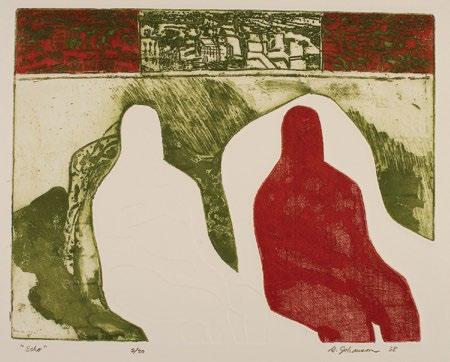
George Johanson
George Johanson (b. 1928 Seattle, WA – 2022). Echo, 1968. Color lithograph. 13 3/4 x 17 3/8 inches. Virginia Haseltine Collection of Pacific Northwest Art; 1973:4.5
George Johanson was a co-founder and first president of Northwest Print Council in Portland, now the Print Arts Northwest. He contributed to Oregon’s tradition of modernism by organizing exhibitions, promoting art acquisitions and collections, and working with students. He was a prolific artist whose murals can be found throughout the region in libraries, parks, hotels, and at Oregon State University.
Echo reveals Johanson’s interest in urbanism and the human body. A seated figure is duplicated on its side, raising questions about personal and collective identity. As Johanson “dislocates, repositions, revises, [and] redefines the figure” he remains committed to exploring broader existential questions while embracing artistic freedom and experimentation. As Roger Hull argues, Johanson’s art “is truly intertextual in that texts from many worlds are layered and merged in his paintings and prints, resulting in new texts that are original in their revealed and concealed meanings.”
George Johanson (n. 1928 Seattle, WA – 2022). Eco, 1968. Litografía de color. 13 3/4 x 17 3/8 pulgadas. Colección de Arte del Noroeste Pacífico Virginia Haseltine; 1973:4.5
George Johanson fue el cofundador y primer presidente del Consejo de Grabado del Noroeste de Portland, ahora conocido como el Print Arts Northwest. Johanson contribuyó a la tradición modernista de Oregón organizando exposiciones, promoviendo adquisiciones y colecciones de arte y trabajando con estudiantes. Fue un artista prolífico cuyos murales pueden encontrarse por toda la región en bibliotecas, parques, hoteles y en la Universidad Estatal de Oregón (OSU por sus siglas en inglés). Eco revela el interés de Johanson por el urbanismo y el cuerpo humano. Una figura sentada está duplicada, planteando preguntas sobre la identidad personal y colectiva. A medida que Johanson “disloca, reposiciona, revisa y redefine la figura”, mantiene su compromiso de explorar preguntas existenciales más amplias y promover la libertad artística y la experimentación. Como afirma Roger Hull, el arte de Johanson “es verdaderamente intertextual en el sentido de que los textos de muchos mundos se superponen y fusionan en sus pinturas y grabados, resultando en textos nuevos que son originales en sus significados revelados y ocultos”.
The Family III
Betty Feves

Betty Feves (b. 1918 LaCrosse, WA– 1985 Pendleton, OR). The Family III, 1958. Ceramic. 17 x 13 x 8 1/2 inches. Gift of Dr. and Mrs. Wallace S. Baldinger; 1981:13.2
Betty Feves is known as a ceramicist, sculptor, mentor, and community leader who advocated for music, education, and fellow artists. Feves contributed to the legacy of modern art in Oregon by creating both public artwork and more intimate pieces as seen in this sculpture.
In The Family III several elongated figures engage in a warm embrace, while others stand nearby, participating in this encounter. The genderless figures are also featureless. A mere semblance of the body reminds viewers of their humanity. Feves’s work evokes not only other non-realist shapes seen in this exhibition, but a dialogue with a broader modern art discourse of artistic exploration and innovation. According to Sue Taylor, “Feves was a maverick, pursuing sculpture at a time when painting ruled, resourcefully mining the margin for all the exhilarating freedom and independence it could provide.”
Betty Feves (n. 1918 LaCrosse, WA – 1985 Pendleton, OR). La familia III, 1958. Cerámica.17 x 13 x 8 1/2 pulgadas. Regalo del Dr. y la Sra. Wallace S. Baldinger; 1981:13.2
Betty Feves es conocida como ceramista, escultora, mentora, y líder comunitaria que abogó por la música, la educación y sus compañeros artistas. Feves contribuyó al legado del arte moderno en Oregón, creando obras de arte público y también piezas más íntimas como se aprecia en esta escultura.
En La familia III, varias figuras alargadas se dan un abrazo cálido, mientras otras permanecen de pie cerca, participando en este encuentro. Las figuras sin género también carecen de rasgos. La mera semblanza del cuerpo recuerda a los espectadores sobre su humanidad. El trabajo de Feves evoca no solamente otras formas no realistas vistas en esta exposición, sino también un diálogo con un discurso de arte moderno más amplio de exploración e innovación artísticas. Según Sue Taylor, “Feves fue una inconformista que se dedicó a la escultura en una época en la que dominaba la pintura, aprovechando hábilmente el margen para toda la libertad e independencia excitantes que esta podía proporcionar”.
Ceramics & Sculptures (Eras Rouge)
Joan Miró
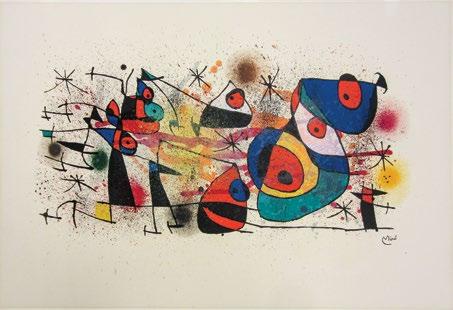
Joan Miró (b. 1893 Barcelona – 1983 Palma, Spain). Ceramics & Sculptures (Eras Rouge), ca. 1973. Ink on paper. 27 3/4 x 18 3/4 inches. Gift of Dr. Roger and Karen Michaelsen; 1999:5.3.1
Joan Miró witnessed World War I, World War II, and the Spanish Civil War. He stated, “the outer world, the world of contemporary events, always has an influence on the painter—that goes without saying…. If the powers of backwardness known as Fascism continue to spread, however, if they push us any farther into the dead end of cruelty and incomprehension, that will be the end of all human dignity…. Retreat and isolation are no longer permissible.”
In this drawing the figures appear in tension. Their gestures and watchful eyes convey a sense of awkwardness and alertness, inviting viewers to remain attentive to their living conditions and surroundings. They meet in an unspecified location, granting them a universality. Devoid of volume and weight, the flat creatures engage with each other through their wide-open eyes and extended arms, touching one another. Miró was fascinated by eyes and their potential to see everything, reflecting his active engagement with the artistic milieu and socio-political context in which he lived.
Joan Miró (n. 1893 Barcelona – 1983 Palma, España). Cerámicas y esculturas (Eras Rouge), ca. 1973. Tinta sobre papel. 27 3/4 x 18 3/4 pulgadas. Regalo del Dr. Roger y Karen Michaelsen; 1999:5.3.1
Joan Miró fue testigo de la Primera Guerra Mundial, la Segunda Guerra Mundial y la Guerra Civil Española. Él declaró que “el mundo de los acontecimientos contemporáneos siempre influye en el pintor; eso no hace falta decirlo...Sin embargo, si los poderes del retroceso conocidos como fascismo siguen expandiéndose, si nos empujan más hacia el callejón sin salida de la crueldad y la incomprensión, ese será el fin de toda la dignidad humana...La retirada y el aislamiento ya no se permiten más”.
En este dibujo, las figuras aparecen en tensión. Sus gestos y ojos vigilantes transmiten una sensación de incomodidad y alerta, invitando al espectador a mantenerse atento a sus condiciones de vida y alrededores. Los sujetos se reúnen en un lugar no especificado, otorgándoles una universalidad. Desprovistas de volumen y peso, las criaturas planas se relacionan entre sí a través de la mirada y sus brazos extendidos, tocándose unas a otras. Miró estaba fascinado por los ojos y su potencial para verlo todo, reflejando su interacción activa con el entorno artístico y el contexto sociopolítico en el cual vivía.
Abstract
Composition (Black and Color Forms)
Joan Miró
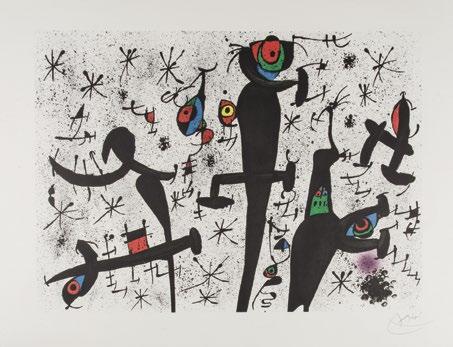
Joan Miró (b. 1893 Barcelona – 1983 Palma, Spain). Abstract Composition (Black and Color Forms), 1971. Color lithograph on Guarro paper. 39 1/2 x 29 1/2 inches. Gift of Dr. Robert and Margaret Leary; 2012:18.4
“I have been doodling all my life. When I was little, I was always drawing,” recalled Joan Miró in 1928. Throughout his career, Miró experimented with various degrees of figuration, occasionally referencing his family’s farm and life in the country and later focusing on space and the unconscious, creating more gestural artworks closer to pure abstraction.
Abstract Composition (Black and Color Forms) embodies a whimsical tone. In this dynamic print Miró imagines the figure anew. Bodies float in space in a dance amidst the stars while watchful eyes stare back at the viewer. In its verticality, the centrally located creature evokes a human being, yet it remains distorted and fragmented, much like its nonhuman companions. Miró’s work parades energy and aesthetic freedom. As Miró claimed, “the essential things are the artistic and poetic occurrences, the associations of forms and ideas: a form gives me an idea, this idea evokes another form, and everything culminates in figures, animals, and things I had no way of foreseeing in advance.”
Joan Miró (n. 1893 Barcelona – 1983 Palma, España). Composición abstracta (formas negras y de color), 1971. Litografía de color sobre papel Guarro. 39 1/2 x 29 1/2 pulgadas. Regalo del Dr. Robert y Margaret Leary; 2012:18.4
“He estado garabateando toda mi vida. Cuando era pequeño, siempre estaba dibujando”, recordaba Joan Miró en 1928. A lo largo de su carrera, Miró experimentó con varios grados de figuración, ocasionalmente haciendo referencia a la granja de su familia y la vida en el campo, y más tarde enfocándose en el espacio y el inconsciente, creando trabajos de arte más gestuales y cercanos a la abstracción pura. Composición abstracta (formas negras y de color) personifica un tono caprichoso. En este dinámico grabado, Miró imagina de nuevo la figura. Los cuerpos flotan en el espacio bailando entre las estrellas, mientras unos ojos vigilantes miran fijamente al espectador. En su verticalidad, la criatura situada en el centro evoca a un ser humano, aunque se mantiene distorsionada y fragmentada, muy similar a sus acompañantes no humanos. El trabajo de Miró derrocha energía y libertad estética. Como Miró afirmó, “lo esencial son las ocurrencias artísticas y poéticas, las asociaciones de las formas e ideas: una forma me da una idea, esta idea evoca otra forma y todo culmina en las figuras, animales y cosas que yo no tuve la manera de prever por anticipado”.
Abstract Forms
Joan Miró

Joan Miró (b. 1893 Barcelona – 1983 Palma, Spain). Abstract Forms, ed. 300/300, after 1967. Ink on paper. 22 x 29 inches. Gift of Eiko Politz; 2013:16.6
Biomorphic abstraction is dominant in this drawing. Nevertheless, familiarity with Joan Miró’s artistic language allows identification of ubiquitous creatures in his oeuvre. A centipede, a fish, and a bird are discernible. A phallic form and a free-floating egg were not alien to his iconography either, and their presence here amongst creatures of nature evokes life and confirms the artist’s free and independent spirit. Devoid of mimesis, the amorphous beings float and meet amidst a dark background, defying gravity and expectations.
Abstract Forms illustrates Miró’s fascination with Surrealism, automatism, as well as hallucinations. Yet, despite an interest in dreamlike imagery and the unconscious, the artist maintained a commitment to figuration. Miró departs from a natural portrayal of the subject to inspire creativity and imagination. As Robin Adèle Greely claims, Miró was invested in “liberating painting from convention, and along with it, liberating both artist and viewer into new inspiration.”
Joan Miró (n. 1893 Barcelona – 1983 Palma, España). Formas abstractas, ed. 300/300, después de 1967. Tinta sobre papel. 22 x 39 pulgadas. Regalo de Eiko Politz; 2013:16.6
La abstracción biomórfica es dominante en este dibujo. No obstante, la familiaridad con el lenguaje artístico de Joan Miró permite la identificación de criaturas omnipresentes en su obra. Un ciempiés, un pez y un pájaro son distinguibles. Una forma fálica y un huevo flotando libremente tampoco eran ajenos a su iconografía, y su presencia aquí entre las criaturas de la naturaleza evoca la vida y confirma el espíritu libre e independiente del artista. Desprovistos de mimetismo, los seres amorfos flotan y se encuentran en medio de un fondo oscuro, desafiando la gravedad y las expectativas.
Las formas abstractas ilustran la fascinación de Miró por el surrealismo, el automatismo, así como también las alucinaciones. Sin embargo, a pesar de su interés por las imágenes de los sueños y el inconsciente, el artista mantuvo un compromiso con la figuración. Miró se aleja de un retrato natural del sujeto para inspirar la creatividad y la imaginación. Como afirma Robin Adèle Greely, Miró se empeñó en “liberar la pintura de las convenciones y, junto con esto, liberar tanto al artista como al espectador hacia una inspiración nueva”.
Damne par l’arc-en-ciel
Roberto Matta
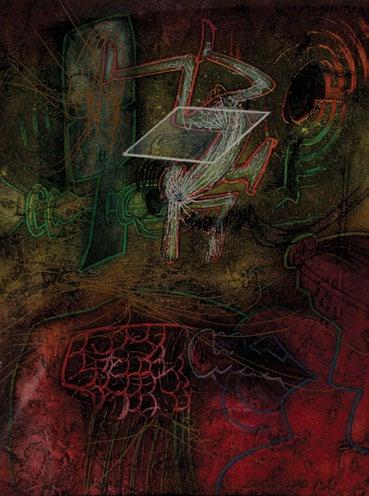
Roberto Matta (b. 1911 Santiago, Chile – 2002, Civitavecchia, Italy).
Damne par l’arc-en-ciel (Plate 5) from the Saison en Enfer Portfolio. Color etching and aquatint. 26 1/2 x 20 1/2. Gift of Dr. Robert and Margaret Leary; 2013:38.33
Roberto Sebastián Antonio Matta Echaurren was an active member of the Paris Surrealist circle. Trained as an architect, he began to paint in Europe, but to escape World War II he moved to New York. He later relocated to other countries. Damne par l’arc-enciel recalls a poem by Arthur Rimbaud and it can be roughly translated as “threatened” or “condemned by the rainbow’s beauty.” Rimbaud’s poem, and Matta’s title, reveal a burden or tension between hope and happiness, and depression and anxiety, and this print belongs to a larger body of work from the portfolio Saison en Enfer (Season in Hell), titled after one of Rimbaud’s most famous works.
Damne par l’arc-en-ciel features a nightmarish world where machines float in space and a humanoid figure appears diving into the unknown. Matta outlines other creatures and objects, but full identification is hindered. In hell or in space, man’s power is questioned and diminished. In this series, as curator John Stringer mentions, “While reducing the role of the human figure, Matta delights in ambiguous descriptions that accord with the dreamworld of Rimbaud’s non-material reality.”
Roberto Matta (n. 1911 Santiago, Chile – 2002, Civitavecchia, Italia).
Damne par l’arc-en-ciel (Grabado 5) del portafolio Saison en Enfer. Aguafuerte y aguatinta de color. 26 1/2 x 20 1/2. Regalo del Dr. Robert y Margaret Leary; 2013:38.33
Roberto Sebastián Antonio Matta Echaurren fue un miembro activo del círculo surrealista de París. Entrenado como arquitecto, él comenzó a pintar en Europa, pero se mudó a Nueva York para escapar de la Segunda Guerra Mundial. Más tarde se reubicó a otros países. Damne par l’arc-en-ciel recuerda un poema de Arthur Rimbaud y puede traducirse aproximadamente como “amenazado” o “condenado por la belleza del arco iris”. El poema de Rimbaud, y el título de Matta, revelan una carga o tensión entre la esperanza y felicidad, y la depresión y ansiedad, y este grabado pertenece a un conjunto de trabajos más amplio del portafolio Saison en Enfer (Temporada en el infierno), titulada igual que una de las obras más famosas de Rimbaud.
Damne par l’arc-en-ciel presenta un mundo de pesadillas donde las máquinas flotan en el espacio y una figura humanoide aparece sumergiéndose en lo desconocido. Matta traza otras criaturas y objetos, pero la identificación completa se ve obstaculizada. En el infierno o en el espacio, el poder del hombre es cuestionado y disminuido. En esta serie, como lo menciona el curador John Stringer, “Mientras reduce el papel de la figura humana, Matta se deleita en las descripciones ambiguas que concuerdan con el mundo soñado de la realidad no material de Rimbaud”.
Two Red Figures
Rufino Tamayo

Rufino Tamayo (b. 1899 Oaxaca, México – 1991 Ciudad de México). Two Red Figures, n.d. Mixografía. 30 1/4 x 22 3/4 inches. . Gift of Dr. Robert and Margaret Leary; 2013:38.37
Rufino Tamayo was devoted to easel painting, but he created over twenty murals and numerous prints, experimenting with diverse techniques and styles. As Tamayo declared, “When I was a student, I moved toward Impressionism. Later, Cubism and Futurism offered me technical challenges.” While living in New York in 1945 he also exhibited with the Abstract Expressionists. Yet, it was in Mexico where he worked on the mixografía technique. This innovative printmaking technique is rich in textures, creating unique qualities on each print.
In Two Red Figures the three-dimensional aspect of mixografía becomes apparent. The twin bodies protrude from the print’s surface, yet they remain overtly flat. Amidst a simplified background, Tamayo’s figures represent not a portrait but a study on geometry, color, space, and form. Human, yet machine-like, the silhouettes exemplify Tamayo’s “alternative modernism,” committed to the human form but resisting both traditional representation and pure abstraction.
Rufino Tamayo (n. 1899 Oaxaca, México – 1991 Ciudad de México). Dos figuras rojas, sin fecha. Mixografía. 30 1/4 x 22 3/4 pulgadas. Regalo del Dr. Robert y Margaret Leary; 2013:38.37
Rufino Tamayo se dedicó a la pintura de caballete, pero creó más de veinte murales y numerosos grabados experimentando con técnicas y estilos diversos. Como Tamayo declaró: “Cuando era estudiante, me incliné por el impresionismo. Más tarde, el cubismo y el futurismo me ofrecieron desafíos técnicos”. Mientras vivía en Nueva York en 1945, Tamayo también expuso con los expresionistas abstractos. Sin embargo, fue en México donde trabajó la técnica de la mixografía. Esta técnica de grabado innovadora es rica en texturas y crea cualidades únicas en cada grabado.
En Dos figuras rojas, el aspecto tridimensional de la mixografía se hace evidente. Los cuerpos gemelos sobresalen de la superficie del grabado, aunque todavía siguen siendo claramente planas. En medio de un fondo simplificado, las figuras de Tamayo no representan un retrato, sino un estudio sobre la geometría, el color, el espacio y la forma. Las siluetas humanas, aunque parecidas más a una máquina, ejemplifican el “modernismo alternativo” de Tamayo comprometido con una forma humana que se resiste tanto a la representación tradicional como a la abstracción pura.
Hom’mere (Chaosmos) VI —H. C. (pour René)
Roberto Matta
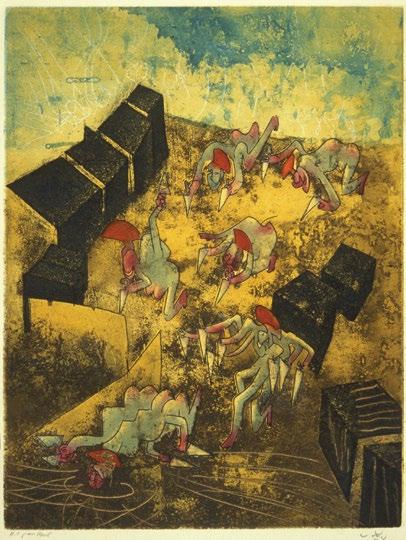
Roberto Matta (b. 1911 Santiago, Chile – 2002, Civitavecchia, Italy). Hom’mere (Chaosmos) VI—H. C. (pour René), 1974. Etching and aquatint. 25 7/8 x 19 3/4 inches. The Elizabeth Cole Butler Graphic Arts Collection, Bequest to the Museum, 2004; 2017:4.20
In Hom’mere (Chaosmos) VI—H. C. (pour René) hybrid creatures inhabit a bleak terrain in which they are the only signs of life. A three-legged, seven-armed individual wanders near another three-armed creature. Next to them, a figure shows its breasts as it crawls near a barrier. They all travel in the same direction guided by a barrier of black slabs that constrain them. They hold weapons shaped like triangular knives, evoking a sense of violence and angst. Their origin and final destination remain a mystery, as do their activities and intentions.
In 1973, after a coup d’état that violently ousted the democratically elected government of Salvador Allende in Chile, General Augusto Pinochet claimed power for several decades. This artwork was created shortly after the end of democracy in Chile and, in 1979, Matta publicly condemned human rights abuses in the country. While this print does not directly reference Chile’s socio-political context, it evokes a simmering state of fear, paranoia, and oppression, an apt allusion to Pinochet’s regime.
Roberto Matta (n. 1911 Santiago, Chile – 2002, Civitavecchia, Italia). Hom’mere (Chaosmos) VI—H. C. (pour René), 1974. Aguafuerte y aguatinta. 25 7/8 x 19 3/4 pulgadas. La Colección de Artes Gráficas Elizabeth Cole Butler, legado para el museo, 2004; 2017:4.20
En Hom’mere (Chaosmos) VI-H. C. (pour René), las criaturas híbridas habitan un terreno desolado en el que estas son las únicas señales de vida. Un individuo de tres piernas y siete brazos merodea cerca de otra criatura de tres brazos. Junto a ellos, una figura muestra sus pechos mientras se arrastra cerca de una barrera. Todos ellos viajan en la misma dirección dirigidos por una barrera de losas negras que los constriñe. Ellos sostienen armas con forma de cuchillo triangular que evocan una sensación de violencia y angustia. Su origen y destino final siguen siendo un misterio, al igual que sus actividades e intenciones.
En 1973, después de un golpe de estado que derrocó con violencia al gobierno democráticamente elegido de Salvador Allende en Chile, el General Augusto Pinochet reclamó el poder durante varias décadas. Esta obra fue creada poco después del fin de la democracia en Chile y, en 1979, Matta condenó públicamente los abusos de los derechos humanos en el país. Aunque este grabado no hace referencia directa al contexto sociopolítico de Chile, evoca un estado latente de miedo, paranoia y opresión, y alude acertadamente al régimen de Pinochet.
Plate IV from the series
“Oda
a Joan Miró”
Joan Miró
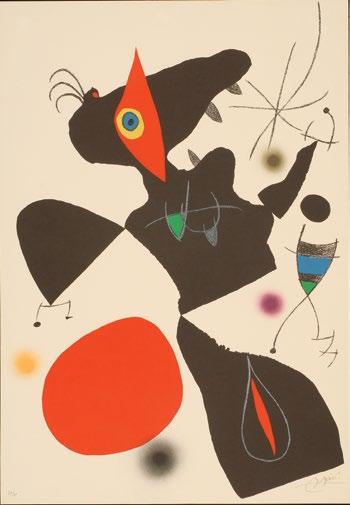
Joan Miró (b. 1893 Barcelona – 1983 Palma, Spain). Plate IV from the series “Oda a Joan Miró, ” 1973. Color lithograph. 34 3/8 x 24 inches. The Elizabeth Cole Butler Graphic Arts Collection, Bequest to the Museum, 2004; 2017:4.24
Joan Brossa was a poet and artist who experimented with Surrealist techniques as he crossed the limits of language, oscillating between literary and visual poetry. Oda a Joan Miró belongs to a larger body of work in which Joan Miró illustrated poems by his friend Brossa. In this ode, a recurring motif of Miró’s work is illustrated by the star. A musical note is also apparent. Yet the composition is dominated by a bilateral amputee. The eye, teeth, breasts, and pubic area are discernible. The flat and fragmented body is surrounded by circles of color that similarly float in space and convey movement.
A sense of uneasiness prevails in Oda a Joan Miró, raising questions about the artwork, its source of inspiration, and the context in which it was created. In 1973, dictator General Francisco Franco was still in power in Spain. While apolitical, the artwork reflects the turbulent times in which it was created. Almost ten years earlier, Miró declared, “Thinking about death led me to create monsters that both attracted and repelled me.”
Joan Miró (n. 1893 Barcelona – 1983 Palma, España). Grabado IV de la serie “Oda a Joan Miró”, 1973. Litografía de color. 34 3/8 x 24 pulgadas. La Colección de Artes Gráficas Elizabeth Cole Butler, legado para el museo, 2004; 2017:4.24
Joan Brossa fue un poeta y artista que experimentó con las técnicas surrealistas mientras cruzaba los límites del lenguaje, oscilando entre la poesía literaria y la visual. Oda a Joan Miró pertenece a un conjunto de trabajos más amplio en el cual Joan Miró ilustró los poemas de su amigo Brossa. En esta oda, un motivo recurrente de la obra de Miró está ilustrado por la estrella. Una nota musical también es aparente. Sin embargo, la composición está dominada por una amputación bilateral. El ojo, los dientes, los pechos y el pubis son distinguibles. El cuerpo plano y fragmentado está rodeado de círculos de color que flotan similarmente en el espacio y transmiten movimiento. Una sensación de desasosiego prevalece en Oda a Joan Miró, planteando preguntas sobre la obra, su fuente de inspiración y el contexto en el cual fue creada. En 1973, el dictador General Francisco Franco todavía estaba en el poder en España. Aunque es apolítica, la obra refleja los tiempos turbulentos en los cuales fue creada. Casi diez años antes, Miró declaró: “Pensar sobre la muerte me llevó a crear monstruos que me atraían y me repelían a la vez”.
Hombre con bastón (Man with Walking Stick)
Rufino Tamayo
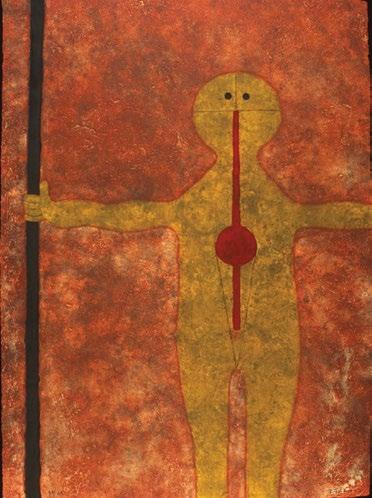
Rufino Tamayo (b. 1899 Oaxaca, México – 1991 Ciudad de México). Hombre con bastón (Man with Walking Stick), 1979. Mixografia. 29 3/4 x 21 3/4 inches. The Elizabeth Cole Butler Graphic Arts Collection, Bequest to the Museum, 2004; 2017:4.28
Rufino Tamayo lived in Mexico, New York City and Paris, and he fiercely advocated for alternative modernisms amidst the hegemonic discourses of Mexican Muralism and Social Realism. Neither an abstract artist nor a traditional realist, he called for a “new realism,” an “abstract figuration” that relied on the figure but departed from its natural representation. This “nondescriptive realism,” as he called it, rejected imitation to favor experimentation and innovation.
In Hombre con bastón, Tamayo’s nondescriptive realism is rendered visible. Devoted to the human figure, the artist outlines the body and key physical features, including arms, fingers, and eyes. Yet in this portrait any identification of the subject is hindered, as well as the environment in which he exists. Tamayo focuses on a study of shapes and color and invites reflection on the possibilities of artistic independence. As he stated, “Art is…besides natural talent and inspiration, a permanent willingness to work, and to work in liberty. Without liberty, work is nothing more than servitude without any creative value or poetic possibilities.”
Rufino Tamayo (n. 1899 Oaxaca, México – 1991 Ciudad de México). Hombre con bastón, 1979. Mixografía. 29 3/4 x 21 3/4 pulgadas. La Colección de Artes Gráficas
Elizabeth Cole Butler, legado para el museo, 2004; 2017:4.28
Rufino Tamayo vivió en México, Nueva York y París, y abogó ferozmente por los modernismos alternativos en medio de los discursos hegemónicos del muralismo mexicano y el realismo social. Sin ser un artista abstracto ni un realista tradicional, él hizo un llamado por un “realismo nuevo”, una “figuración abstracta” que se basara en la figura, pero que se apartara de su representación natural. Este “realismo no descriptivo” como él lo llamó, rechazaba la imitación para favorecer la experimentación y la innovación.
En Hombre con bastón, el realismo no descriptivo de Tamayo se hace visible. Dedicado a la figura humana, el artista delinea el cuerpo y los rasgos físicos claves, incluyendo los brazos, dedos y ojos. Sin embargo, en este retrato se dificulta cualquier identificación del sujeto, así como también el ambiente en el que existe. Tamayo se enfoca en un estudio de las formas y el color e invita a reflexionar sobre las posibilidades de la independencia artística. Como él declaró: “El arte es... además de un talento natural e inspiración, una disposición permanente para trabajar, y para trabajar en libertad. Sin libertad, el trabajo no es más que una servidumbre sin valor creativo ni posibilidades poéticas”.
The Moon Seemed to Fill Her Up
Rick Bartow

Rick Bartow (b. 1946 Newport, OR – 2016). Native American, Mad River band of the Wiyot Tribe. The Moon Seemed to Fill Her Up, 2006. Monotype. 30 x 22 inches. Gift of Bill Avery; 2017:22.4
Rick Bartow was an enrolled member of the Mad River Band of Wiyot Indians, and he is considered a leading figure in the Pacific Northwest art community and in contemporary Native American art. His artwork shows an interest in the afterlife, transformation, and repatriation. Bartow examines social issues to bring awareness and change in our communities. As Lawrence Fong explains, “Through the artist’s bearing of his personal psychological and spiritual pathways, the truth is revealed about injustices facing Indians today.”
Bartow often embraced a gestural style, departing from a strictly figurative art to convey myriad emotions such as angst and dread, but also solitude, healing, and a meditative state. In The Moon Seemed to Fill Her Up, a fragmented, flat, and still silhouette is disrupted by scratches and lines that target the body while a crescent moon hovers above it. The ambiguity found in the subject and its setting exemplifies Bartow’s interest in aesthetic exploration and an interrogation of our reality and the process of representation itself.
Rick Bartow (n. 1946 Newport, OR – 2016). Nativo americano, alianza Mad River de la tribu Wiyot. La luna parecía llenarla, 2006. Monotipo. 30 x 22 pulgadas. Regalo de Bill Avery, 2017:22.4
Rick Bartow fue un miembro registrado de la alianza Mad River de los indios Wiyot, y se considera como una figura destacada en la comunidad de arte del Noroeste Pacífico y en el arte nativo americano contemporáneo. Sus obras muestran un interés por la vida después de la muerte, la transformación y la repatriación. Bartow examina los problemas sociales para crear conciencia y cambiar nuestras comunidades. Como explica Lawrence Fong: “A través del recorrido que el artista hace de sus trayectorias psicológicas y espirituales personales, la verdad se revela sobre las injusticias enfrentadas por los indios hoy”.
Bartow con frecuencia adopta un estilo gestual, apartándose de un arte estrictamente figurativo para transmitir una miríada de emociones como la angustia y el pavor, pero también la soledad, la sanación y un estado meditativo. En La luna parecía llenarla, una silueta fragmentada, plana e inmóvil se ve interrumpida por los rasguños y líneas que apuntan hacia el cuerpo mientras una luna creciente se cierne sobre esta. La ambigüedad encontrada en el sujeto y su entorno ejemplifican el interés de Bartow por la exploración estética y una interrogación sobre nuestra realidad y el propio proceso de representación.
Raindance
Ka’ila Farrell-Smith

Ka’ila Farrell-Smith (b. 1982 Ashland, OR). Raindance, 2022. Monoprint, screen print, spray paint on hand dyed Arnhem 1618 paper. 20 x 15 inches. Proposed: Promised Gift of Bill Avery; L2024:10.7
Ka’ila Farrell-Smith is a Klamath Modoc contemporary artist currently living in Modoc Point, Oregon. As activist and artist, her work focuses on reclaiming erased histories and traditions and confronting extractivism. Her father was a survivor of the colonial boarding school system, and her artistic practice is influenced by him and her family’s trauma and experiences with the U.S. government. Her artwork engages with a Western and non-Western art tradition as a means to decolonize the discipline of art and art history and acknowledge her Native American roots.
In Raindance, Farrell-Smith reconciles a tradition of gestural abstraction with ceremonial practices and figuration. It depicts a few figures floating in an unformed space. Neither representational nor purely abstract, the flat shapes convey energy and a sense of movement as their arms appear extended or raised. While ambiguity reigns in this composition, the artwork’s title provides clues about Farrell-Smith’s commitment to and advocacy for tribal practices.
Ka’ila Farrell-Smith (n. 1982 Ashland, OR). Danza de la lluvia, 2022. Monotipo, serigrafía, pintura en aerosol sobre papel Arnhem 1618 teñido a mano. 20 x 15 pulgadas. Propuesto: Regalo prometido de Bill Avery; L2024:10.7
Ka’ila Farrell-Smith es una artista contemporánea klamath modoc que vive actualmente en Modoc Point, Oregón. Como activista y artista, su trabajo se centra en reclamar las historias y tradiciones borradas y confrontar el extractivismo. Su padre fue un sobreviviente del sistema colonial de internados, y su práctica artística está influida por él y por el trauma y las experiencias de su familia con el gobierno de los Estados Unidos. Su obra de arte se involucra con una tradición artística occidental y no occidental como un medio para descolonizar la disciplina del arte y la historia del arte y reconocer sus raíces nativas americanas.
En Danza de la lluvia, Farrell-Smith reconcilia la tradición de la abstracción gestual con las prácticas ceremoniales y la figuración. Esta representa unas cuantas figuras flotando en un espacio sin forma. Sin ser representativas ni puramente abstractas, las formas planas transmiten energía y una sensación de movimiento cuando sus brazos aparecen extendidos o levantados. Aunque la ambigüedad predomina en esta composición, el título de la obra ofrece pistas sobre el compromiso de Farrell-Smith con y la defensa de las prácticas tribales.
Kind Friend
Emma Kohlmann
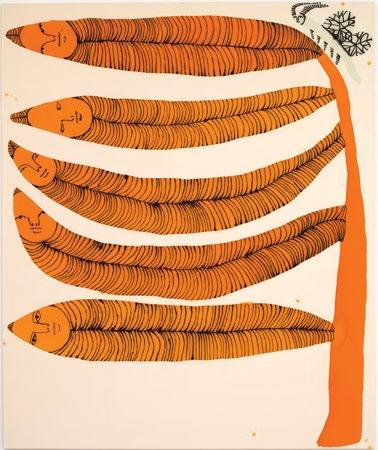
Emma Kohlmann (b. 1989 New York). Kind Friend, 2020. Acrylic on canvas. 60 x 50 inches. Gift in honor of Eugenia Crenovich (Yente); 2024:21.1
Emma Kohlmann is an emerging artist based in Massachusetts, whose work centers on the human body. Her work explores desire, sexuality, and pleasure through a variety of figures whose features remain largely indiscernible. Kohlmann portrays colorful silhouettes which, while figurative, are reduced to simple lines and shapes to convey their bodily forms. She negates a sense of volume and weight in her subjects, allowing them to freely float in space.
Kohlmann often depicts disembodied elements intermingled with nature to represent our coexistence with non-humans. Floral motifs, bugs, and other insects appear sporadically throughout her artworks, playfully recalling Surrealism’s odd juxtapositions. Yet, within today’s socio-political context, her figures offer thoughtful commentary on identity and a kind of activism that advocates for communion with the environment.
Emma Kohlmann (n. 1989 New York). Amigo bondadoso, 2020. Acrílico sobre lienzo. 60 x 50 pulgadas. Regalo en honor de Eugenia Crenovich (Yente); 2024:21.1
Emma Kohlmann es una artista emergente que reside en Massachusetts y cuya obra se enfoca en el cuerpo humano. Su obra explora el deseo, la sexualidad y el placer a través de una variedad de figuras cuyos rasgos se mantienen en gran medida difíciles de distinguir. Kohlmann representa siluetas coloridas que, aunque son figurativas, se reducen a líneas y formas simples para transmitir sus formas corporales. Kohlmann les niega una sensación de volumen y peso a sus personajes, permitiéndoles flotar libremente en el espacio.
Kohlmann con frecuencia representa elementos incorpóreos entremezclados con la naturaleza para representar nuestra coexistencia con los no humanos. Los motivos florales, bichos y otros insectos aparecen esporádicamente en todas sus obras, recordando juguetonamente las extrañas yuxtaposiciones del surrealismo. Sin embargo, dentro del contexto sociopolítico actual, sus figuras ofrecen comentarios reflexivos sobre la identidad y un tipo de activismo que aboga por la comunión con el medio ambiente.
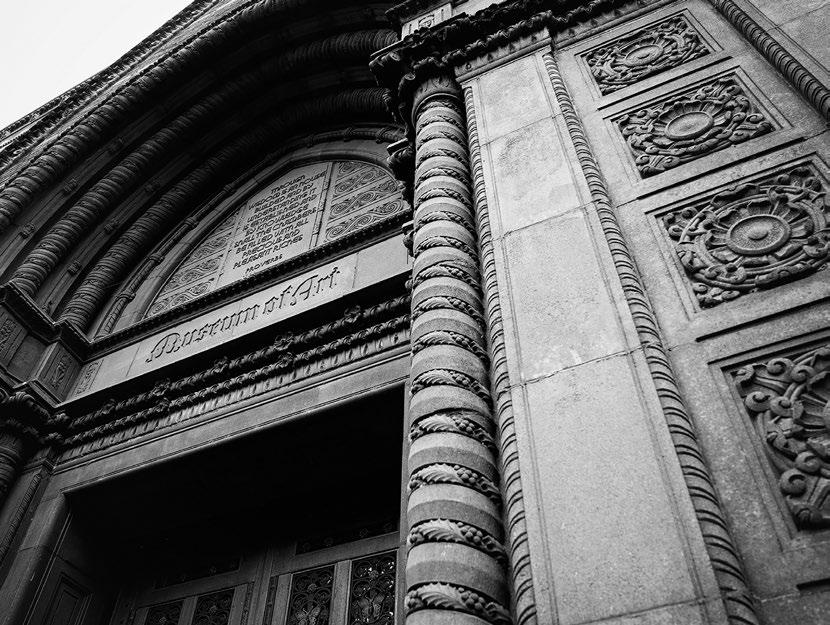
University
About the Jordan Schnitzer Museum of Art
The only academic art museum in Oregon accredited by the American Alliance of Museums, the University of Oregon’s Jordan Schnitzer Museum of Art (JSMA) features engaging exhibitions, significant collections of historic and contemporary art, and exciting educational programs that support the university’s academic mission and the diverse interests of its off-campus communities. The JSMA’s collections galleries present selections from its extensive holdings of Chinese, Japanese, Korean and American art. Special exhibitions galleries display works from the collection and on loan, representing many cultures of the world, past and present. The JSMA continues a long tradition of bridging international cultures and offers a welcoming destination for discovery and education centered on artistic expression that deepens the appreciation and understanding of the human condition.
Translation
to Spanish by
Irene Arce | Traducción al español por Irene Arce
